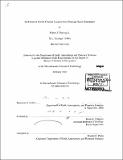Prediction of stream channel location from drainage basin boundaries
Author(s)
Fleming, Robert J. (Robert James), 1962-
DownloadFull printable version (6.494Mb)
Other Contributors
Massachusetts Institute of Technology. Dept. of Earth, Atmospheric, and Planetary Sciences.
Advisor
Kelin X. Whipple.
Terms of use
Metadata
Show full item recordAbstract
Common methods of extracting representations of drainage networks from raster digital elevation models for hydrological and geomorphological applications are similar to a class of image processing methods known as grayscale watershed algorithms. These algorithms partition a field of scalar values into connected regions based on a local minimum associated with each region. A related class of image processing algorithms, known as 2-dimensional skeletonization algorithms, reduce a planar shape to a one-dimensional, connected, graph-like structure, called a skeleton, that maintains significant information about the properties of the original shape. The morphological similarity between the skeleton of a region and a drainage network suggest that skeletonization algorithms might be used to relate basin shape to the drainage network within the basin. This idea was examined by applying two 2-dimensional skeletonization algorithms to two drainage basin boundary shapes extracted from digital elevation models to attempt to predict stream channel locations within the basin. The skeletons computed for the two basins studied did not predict the location of principal channels in the interiors of the basins studied. This is due, at least in part, to the fact that these two dimensional algorithms only consider symmetry with respect to plan view basin shape, with no consideration made of relative elevations along basin boundaries or position of the boundary points with respect to the basin outlet. In convex outward salients of the upper reaches of the two basins studied, the position and planform of computed skeletons agree reasonably well with the upper reaches of drainage networks derived from the digital elevation model. This observation suggests a relationship between basin boundary shape and the location and form of the channel network, at least in the neighborhood of the boundary in upper portions of the basins. A brief review of recent results from computational geometry and image analysis suggest several possible methods of extending this analysis to incorporate relative elevation along the boundary and orientation of the boundary with respect to the basin outlet, and possibly resolving this question.
Description
Thesis (S.M.)--Massachusetts Institute of Technology, Dept. of Earth, Atmospheric, and Planetary Sciences, 2001. "February 2001." Includes bibliographical references (leaves 17-19).
Date issued
2001Department
Massachusetts Institute of Technology. Department of Earth, Atmospheric, and Planetary SciencesPublisher
Massachusetts Institute of Technology
Keywords
Earth, Atmospheric, and Planetary Sciences.